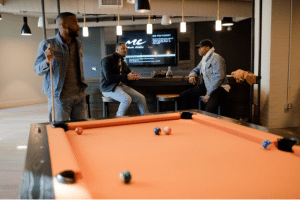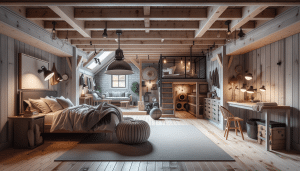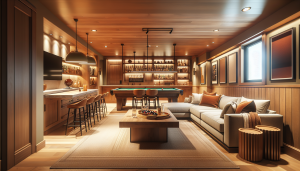Turning a basement into a rentable apartment in Salt Lake City is one of those ideas that sounds simple—“throw in a kitchen and a door, done!”—but once you get into it, you realize there’s a smart way to do it and a messy way to do it. Let’s stay in the smart lane. Between local rental demand (hello, students, college kids, remote workers, and family members who “just need a place for a bit”) and the fact that basements in Utah actually stay pleasant through our hot-cold seasons, a well-finished basement unit can become solid monthly income. The key is planning it like you’re the tenant. What would you want if you were paying rent downstairs?
Contents
- 1 Start with what the city cares about (because they do)
- 2 Give it its own entrance (that actually feels like an entrance)
- 3 Light it like you’re fighting the basement stereotype
- 4 Soundproof like you’re the one trying to sleep
- 5 Kitchenette vs. real kitchen—don’t cheap out too far
- 6 Make the bathroom tenant-friendly (read: low-maintenance)
- 7 Flooring that doesn’t hate basements
- 8 Storage and laundry—the two sleeper features
- 9 Price it like a business, present it like a home
- 10 Ready to build it right?
Start with what the city cares about (because they do)
Before you frame a single wall, check what Salt Lake City or your specific municipality says about accessory dwelling units (ADUs), basement apartments, and egress requirements. Some areas are friendlier than others. You may need:
- Legal egress windows in sleeping areas
- Proper ceiling height (often 7’ or more)
- A separate entrance
- Smoke/CO detectors that actually talk to each other
Here’s the thing—if you skip this part, everything else becomes harder. A “cute” illegal basement is harder to insure, harder to sell, and sometimes you can’t even list it openly. Do it the right way and you’ve got real, bankable value. Honestly, this is where hiring a local basement finishing crew that’s already worked in SLC pays off, because they already know what inspectors love and what they side-eye.
Give it its own entrance (that actually feels like an entrance)
Tenants like privacy. You like privacy. Salt Lake families really like privacy. So a separate, well-lit entrance matters. If the only way in is through the garage, past your storage, then through the laundry, that’s not a rental—it’s a favor.
What helps:
- A walkout or side entrance with good winter lighting
- Covered stairs so ice isn’t an issue
- A door that doesn’t scream “back basement door”
Little thing: add a doorbell and a mailbox label. Those small cues tell renters, “Yes, this is your home, not just a corner of ours.”
Light it like you’re fighting the basement stereotype
Basements already have to overcome the “dark and kind of gloomy” stigma. You beat that with layers of light:
- Recessed LEDs on dimmers
- Warm-tone bulbs (not the cold, office-feeling ones)
- Strategic mirrors across from windows
- Bigger egress or window wells if your layout allows
You know what? People will forgive a small space faster than a dark space. Bright + clean = rentable. Bright + clean + quiet = rentable at a better rate.
Soundproof like you’re the one trying to sleep
This is the piece most DIY basement apartments miss. If your kids are upstairs doing Fortnite voice chat or the dog is sprinting from window to window, your tenants will hear it. And if your tenants are night-shift nurses, you’ll hear them. That’s not good for anyone.
Quick wins:
- Resilient channel or sound-isolating clips in the ceiling
- Insulation in internal walls (yes, even between bedroom and living room)
- Solid-core doors, not hollow ones
It’s not totally silent (basements rarely are), but reducing noise makes your place feel closer to a real apartment than a converted space.
Kitchenette vs. real kitchen—don’t cheap out too far
Here’s where people go two different directions. One group says, “Let’s just give them a microwave, mini fridge, and call it good.” The other group goes full chef’s kitchen. Both can be wrong.
A strong middle-ground basement rental in Salt Lake City usually has:
- 30” or apartment-size range
- Full fridge (tenants stay longer when they can actually store food)
- Decent cabinets—Shaker whites work great in basements
- Durable countertop (laminate is fine; butcher block if you want charm)
Think: “Could someone live here for a year comfortably?” If the answer’s yes, you widen your tenant pool. Students, couples, recent transplants, grandparents—suddenly everyone’s a fit.
Make the bathroom tenant-friendly (read: low-maintenance)
Basement bathrooms should be designed for moisture and repeat use. That means good ventilation, tile or LVP, and fixtures that don’t demand constant scrubbing. A one-piece shower unit is actually smart here—it’s not fancy, but it drains well and cleans easily. Add a fan that’s quiet enough not to echo through your floor joists, and you’ve made it livable.
Flooring that doesn’t hate basements
Utah basements can get cold, and sometimes there’s a little moisture risk. That’s why carpet over pad everywhere isn’t always the best plan. Consider:
- Luxury vinyl plank (warmer than tile, tougher than carpet)
- Area rugs to soften bedrooms and living areas
- Radiant heat if you really want to spoil renters (this rents fast)
People like spaces where their feet aren’t freezing in February.
Storage and laundry—the two sleeper features
This is the part renters don’t ask for—but they love when it’s there. A hallway closet, a pantry, or even a small locked storage room makes the space feel livable. If you can safely give basement tenants access to laundry (even shared), your listing beats half of the basement apartments in the area.
Price it like a business, present it like a home
Yes, this is an income project. But basement apartments rent faster when they feel warm and finished, not like a flipped storage room. Consider seasonal staging—light blankets in winter, a few neutral wall pieces, maybe a plant or two (real or faux). Tenants in Salt Lake City get that basements are common here; what they don’t get often is a basement that feels intentional.
Ready to build it right?
If your head’s already spinning with layout ideas, windows, and “where do I put the kitchen?”—that’s normal. Basement apartments are a puzzle, but they’re a profitable puzzle when you build them to code, make them bright, and give tenants privacy. We’ve finished a lot of Utah basements, and we know what local renters actually care about.
Let’s talk through your space, see what’s allowed, and map out a floor plan that actually rents.
- By Phone: 801-515-3473
- By Form: https://utbasementfinishing.com/request-quote/#go




